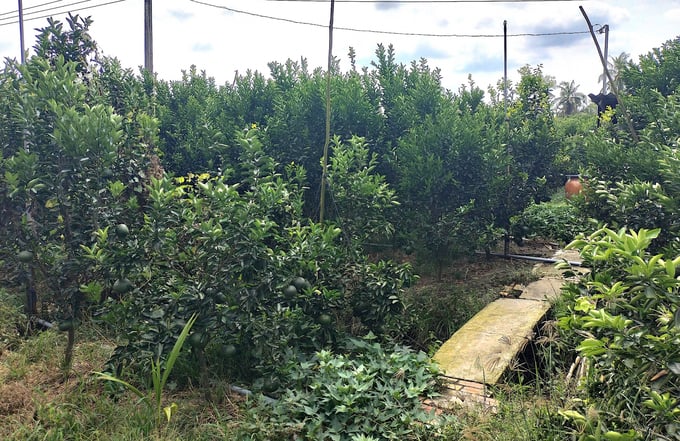
The price of beautiful oranges in the garden is only 5,000 VND/kg. Picture: Minh Dam.
area is heating up
Currently, the price of beautiful oranges in the garden is only VND 5,000/kg. For the new orange plantations for the war fruit (first generation), the price is 2,000 – 3,000 VND/kg, even in the gardens with large output, the traders do not buy, ripe oranges fall into the garden.
According to traders, before the Lunar New Year, oranges cost VND 12,000/kg. Since then, the price of oranges has fallen sharply due to a sharp drop in consumer demand in the northern provinces. Currently, market consumption has decreased by more than 50%.
According to Vinh Long Provincial Plant Protection and Cultivation Subdivision, the province’s orange area has currently exceeded 18,000 hectares and is concentrated in Tra On, Tam Binh, Vung Liem and Binh Minh districts. Orange is a very easy object to grow, so farmers are expanding very quickly, which leads to a large production volume, oversupply and a sharp drop in prices at that time.
According to the Tam Binh District Ministry of Agriculture and Rural Development, the area of rice land converted into orange-oranges has been about 1,000 hectares in the past three years. Most of these orange areas developed spontaneously not according to the planning area because people from other provinces like Ben Tre, Tien Giang, Tra Vinh came to lease land for planting. The orange cultivation model is very large, from 200 to 300 trees/person, so the output is very high. The yield in the first batch is about 5-6 tons/ton, the second batch is about 7-10 tons/ton.
At present, oranges are only consumed in the form of fresh food, squeezed into water to make soft drinks in the domestic market, but cannot be exported. Deeply processed products made from tart oranges have not yet been developed. In the Mekong Delta, many oranges are grown in the provinces of Vinh Long and Hau Giang.
In recent years, the area has grown significantly due to the stable orange price. However, this crop is considered to be a get-rich-quick tree and also a get-poor one as the investment cost for 1 hectare of oranges is between VND 600-900 million (at leased land).
Mr. Ut Em in Thong Nguyen Hamlet, Loan My Municipality, Tam Binh District, Vinh Long Province has 15 workers (15,000 m2) who are harvesting oranges for the first time, with an expected yield of about 6 tons/ton. He said each investment so far totaled 120 million dongs, including money for seedlings, land leases, fertilizers, pesticides and caregivers.
In recent years the price of oranges has been very stable, the first batch has just been harvested and the grower has paid back the investment. Subsequent deals will be profitable. At this price, the money is not enough to take care of the trees for the next harvest, he said he has to invest more money, otherwise the next harvest will not yield.

The model of local people’s cultivation of oranges is very thick, in some places the distance is only 0.9 m. Picture: Minh Dam.
Recommendations to focus on care
The price of oranges is low, people have the mentality of waiting for the price to easily lead to the trees being exhausted. The Department of Agriculture and Rural Development of Vinh Long Province recommends people focus on tree care, especially proper irrigation and fertilization. According to Mr. Lam Van Chanh, deputy chief of Tam Binh District Department of Agriculture and Rural Development, he said:
“The industry recommends not to get discouraged, but to focus on watering and supplementation. With good care, oranges can stay on the tree for about 10 days. If not, oranges are easy to lose water, not pretty, dealers do not buy. After that, the trees that are still exhausted can die or there will be no more yield in the next season.”
Mr. Chanh added that orange is the district’s main crop and has long had a brand name. Currently, Khanh Nhan’s orange products are certified by 3-star OCOP products. In addition, the unit also cooperated with a company to create digitized data on the orange-growing area map and the Zalo network to promote the consumption of the district’s oranges.
However, Mr. Chanh also thought: The model of growing oranges is very thick, the distance between the two trees is 0.9m-1.2m. The usage cycle of about 4-5 harvests will cause the orange tree to no longer produce effective yields delivers. People have to curb investments from the start or switch back to rice cultivation.
Over-cultivation almost depletes the nutrients in the soil. When planting new orange trees or rice plants, a lot of fertilizer has to be invested in order to achieve an effective yield. In the case of rice plants in particular, it takes up to 2 years for the nutrients in the soil to be balanced again.

